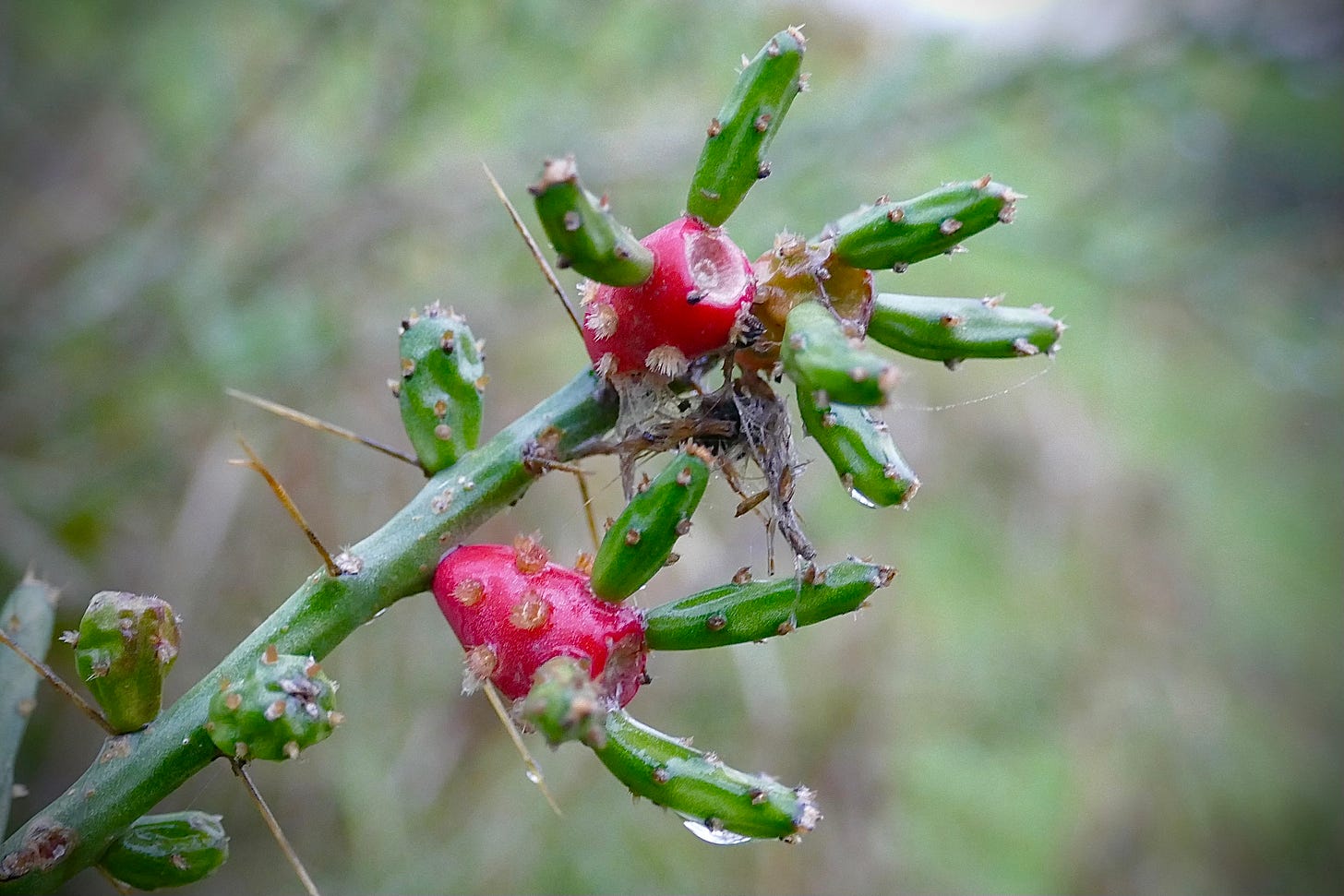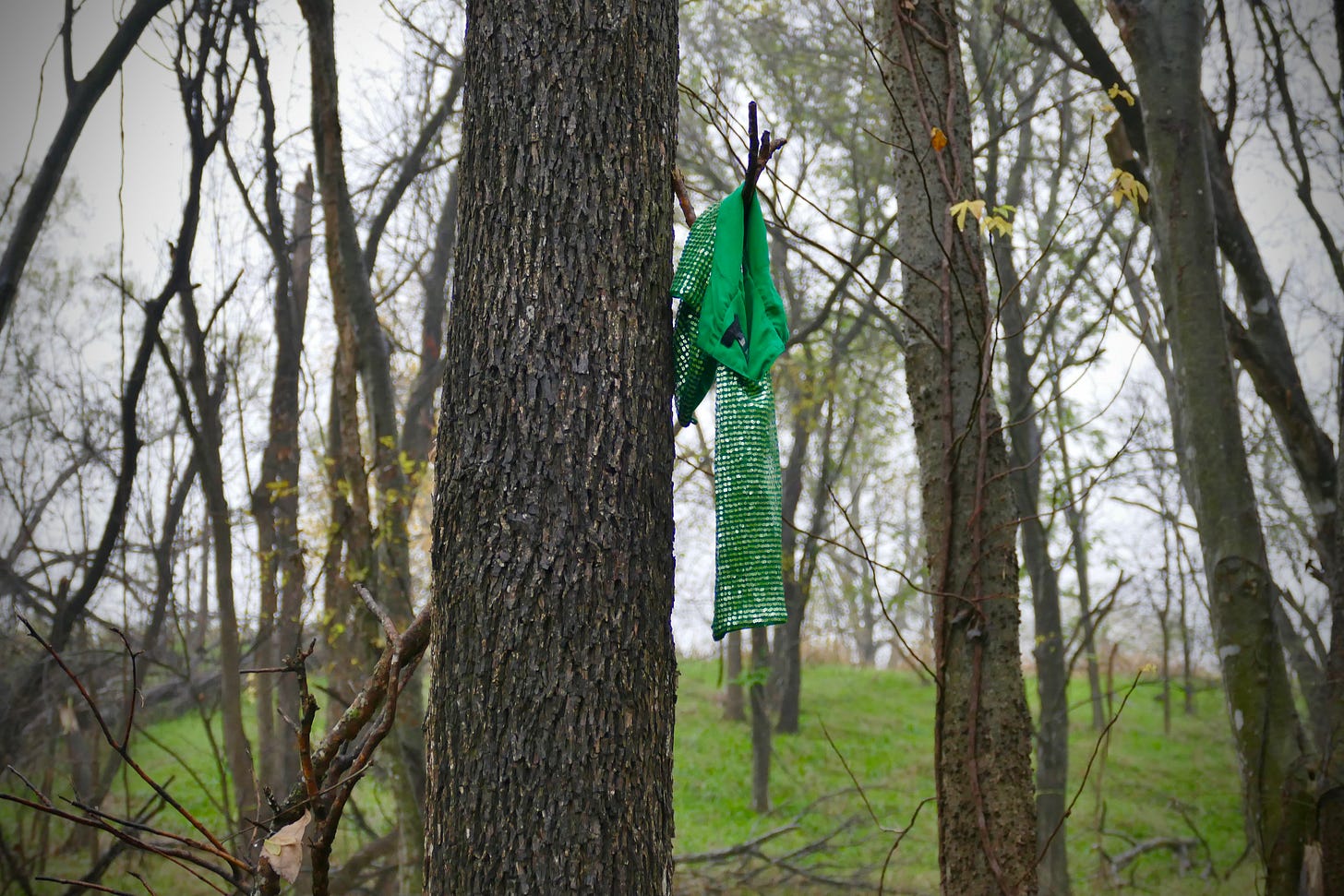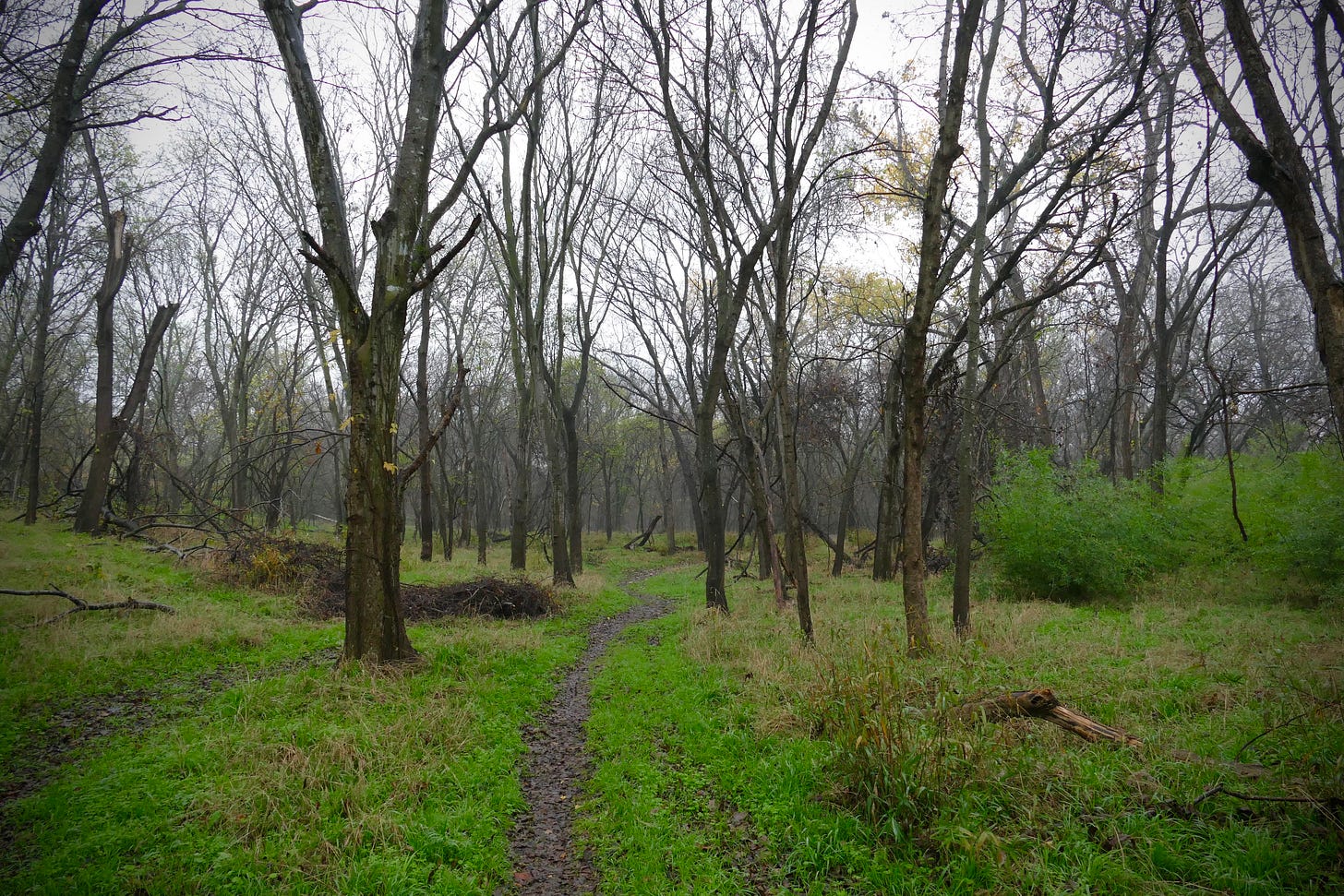Winter Ghosts
No. 144
If you look up Cylindropuntia leptocaulis, the pencil cactus sometimes called Christmas cholla and more commonly known down here as tasajillo, the botanical entry will likely note what becomes obvious as soon as you read it: that the plant, covered in spines, both the long thick kind that repel you from even coming close, and the smaller clusters of fine spines that would likely stick in your throat if you tried to eat the enticing little bulbs, is deer resistant. That explains why it flourishes in patches in the unfenced dry uplands at the edges of the city, despite the abundance of hungry ruminants. It’s less common in the floodplain. I’ve only found one specimen in the acres of empty lots behind the factories around our home in East Austin, an individual plant that has been there longer us, fifteen years now, growing on the grade between an irregularly mowed industrial park and the riparian woods. When I see it this time of year, it always makes me think of Frazer’s decoding of the story of Balder and the mistletoe in The Golden Bough. A solstice plant that encodes winter’s paired promises of death and rebirth. Even if, in the case of tasajillo, that’s not really the deal.
The barred owls that hunt that zone have sounded a little different this winter, when I hear them in the waning hours of our long nights. The notes are shorter, making them sound a little more distant, even when they’re closer. I always listen for them when I cross our patio after dark, seeking the reassurance that they are still there. Wednesday morning instead of owls I heard construction, the sort of construction that sounds more like destruction. I thought it was demolition beginning at the shuttered dairy plant, to make room for the offices, hotels and condos approved this summer, but when I went to investigate a little later I saw it was just the ongoing site prep of the deserted traffic island I memorialized last time. Still, when I read that tasajillo propagate through cloning, I got to thinking I might want to save a sample of that specimen before it’s gone.
The coyotes have been quieter this winter, but I know they’re out there, as the season when they get frisky approaches. I’ve been seeing four of them coming and going behind our back gate at night, the only members of our edgeland menagerie too big to sneak through the aperture between gate and fence and come find a midnight snack on our green roof. In the trailcam videos, they often stop for a long look in the direction they are going or coming from, those almost bat-like ears no doubt tuned into some sound we can’t hear. Dinner is not as easy for them, even as they seem well-adapted to the predatory opportunities the city affords. Sometimes when the first responders crank their sirens as they hurtle down the high-speed roadways on the other side of the fences, you hear the coyotes call back from the darkness of the urban woods.
The morning of the solstice, at day break on Saturday, right after the rain finally stopped, the black mouth cur and I went out for a walk on the paths those coyotes travel. We followed the right of way behind the door factory, a path that once led to a ferry landing but now is only used by wild animals and telecommunications cables. I’ve spent most of the year writing a book about the things we’ve seen and learned rambling these zones, which ironically meant we haven’t had much time for longer walks in them. And it always amazes me how quickly you can step off the pavement and into the feral. Right behind the gypsum yard, as some dude loaded pallets of drywall on a flatbed truck, we encountered our first deer carcass of the season. Wet ribs sticking out of the brome, with fur still on the head, another clump around the hind legs, and scatterings of white fur nearby. A couple of days old, probably, with most of the meat picked off the bones by scavengers. Perhaps the scene that preceded is there on some backlot security camera footage no one has watched but the bots.
Deeper in the woods, down in the expanse of the floodplain, most of the man camps of summer had cleared out. Where one tent had stood along the clearing, only a small pile of trash remained, with charging papers, a fragment of a twelve step handbook, a pack of Lucky Strikes, the printed rules for how to make your bed area in the shelter, a scratch-off lotto card, a Snickers wrapper, and the pieces of a jigsaw puzzle scattered in with the leaf litter.
Further along the path, right by the spot where Cameron Krow’s enigmatic and alluring Sanctuary Portal once stood, we came upon evidence of some elf losing part of its jacket scampering through the urban forest, like Peter Rabbit’s coat caught in the bramble. Here in the country where Santa doesn’t need to deal with the snow, and can sometimes be seen tearing up the mud in an ATV, or drinking high gravity lager by a campfire in the urban woods.
We stopped buying each other presents a few years ago, except for the children, and it is a liberating thing to do. It makes more space to tune into these holidays’ roots in the natural world outside the back door. The darkness and danger, the possibility of cold, the promise of another morning, the sanctuary of shared shelter, home and hearth.
Last weekend my friend Phil, who makes his shelter in an abandoned building further into this territory, left me a book outside our gate, with a note of holiday greeting that managed to name check in one short page Gregg Allman, Geoffrey Household, Jackson Browne and J.A. Baker, and centered around an image of balloons coming down from the ceiling and the possibility that it could be a hailstorm. The book was an Anne Tyler novel from 1988, Breathing Lessons. Hardback, first edition, slight water damage. Opening line: “Maggie and Ira Moran had to go to a funeral in Deer Lick, Pennsylvania.”
Tuesday night we worked out a deal with the developers who want to rezone the post-industrial hellscape around Phil’s squat for a fancy new mixed-use development. The agreement will do a decent job of protecting the river and riparian habitat that somehow has maintained its natural condition behind the aggregate mines and asphalt yards, with ample setbacks, protections against light and noise pollution, and native landscaping requirements. We have work yet to do on figuring out how to address the human displacement it will cause.
When Lupe and I finally made our way to the river, it was full of ducks. I had seen them and heard them, fragments of flocks glimpsed while driving in traffic, or walking into the grocery store. But when you walk down into the wide shallow channel beneath the overpass and see the hundreds of them there settled in for the winter, pintails and mallards and others I no doubt missed, you get a reminder of how the city can still make room for other life, even if it mostly does so by accident.
On the opposite bank, a lone caracara tried to figure out how to use that epic, almost self-parodic beak to eat the best parts of a nice-sized fish it had in its talons, likely one it had found grounded after the rainwaters receded. The ospreys, like the one we saw a little further along the river, are the ones who take the fish from the water.
If it’s nice today, my daughter, my mom and I may get back out like we did last Sunday, and see what life comes out in the quiet, as the contrails that mar the morning sky with their accidental glyphs bleed into the atmosphere above the rewilded gravel dredge behind our home, and whatever weird new nature it is that’s taking shape in the world we made starts to show itself.
Stocking stuffers
In pre-Mycenaean art, the chariot of the sun god was often pulled across the sky by a stag. Or so we are told by Louis Charbonneau-Lassay in The Bestiary of Christ, an amazing encyclopedia of symbolic associations of animals, mythological as well as Biblical, that a reader recommended to me a while back and I have referred to frequently since tracking down a copy. An abridged copy, I should note, the version translated by Gurdjieff protégée Dorothea Dooling for Parabola Books and published in 1991. The original French version was published in an edition of 500 in 1940, almost all of which were burned along with most of the original woodblocks of the illustrations when a bomb destroyed the warehouse where they were stored as the war broke out. One of those books you can’t help but think is some Borgesian invention, but there it is.
For more on the wild spaces the city hides, two amazing stories in the major dailies about urban wetlands trying to come back up through the pavement: Hilary Howard at the NYT on “the Hole,” a neighborhood on the border between Brooklyn and Queens that is so low in elevation—about four feet above sea level—that it remains unconnected to the city sewer system to this day; and Dana Priest in the Washington Post on the creeks buried under the Federal Triangle and the Mall, which almost brought down the Washington Monument during the construction of the National Museum of African-American History and Culture. Sous les pavés, le marais?
For secret solstice rituals of the Midwest, check out Cahokia Woodhenge.
My friends at Aqueduct Press, the Seattle-based publisher of feminist SF and other fantastic literature, have their annual roundup of guest posts on the year in reading (and watching and listening), with interesting contributions (17 so far, and probably double that by New Year’s) from the likes of Lisa Tuttle, Nisi Shawl, and Eleanor Arnason. My own entry should be up sometime in the next week.
If you’re looking for a conservation book for a kid, our friend and neighbor Raina Garland James’ wonderful new picture book Hope Beach, illustrated by Katherine Gutovskiy, is now available at Barnes & Noble.
And here’s some trailcam video of a ringtail cat sneaking in and out of our yard early on the morning of the solstice. Catch the leap on the back end:
Merry Christmas to those who celebrate it, and Happy New Year. Field Notes will be back in January.









Magnificently written. Thanks for taking me on a stroll in your neighborhood. You've captured the way our consciousness makes deeper connections when grounded in the natural world.
Thought you might enjoy this photo of the vast vacant lot that the Lincoln Memorial intruded on - I found it in a photo album bought on eBay a few years back: https://www.flickr.com/photos/rock_creek/50694461683
There was a dump on one edge of it, but it was basically just scrub woods, weeds + pools of stagnant water from the time the land was made out of mud dredged from the Potomac in the 1880s until construction got underway in the early 20s.